 Last additions - Higashi-Omi 東近江市 Last additions - Higashi-Omi 東近江市 |
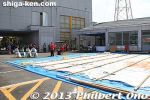
Behind the ceremony is the giant kite waiting for more wishing stickers.Jun 12, 2013
|
|
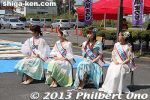
The Wind Goddesses are like festival princesses who pray for good wind to blow to fly the giant kite.Jun 12, 2013
|
|
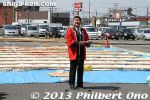
Mayor of Higashi-OmiJun 12, 2013
|
|
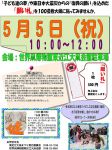
On May 5, 2013 (Children's Day), the kite museum held an event for children to write their wishes on paper stickers to be affixed on the back of the giant kite.Jun 12, 2013
|
|
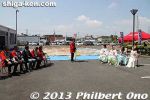
It started with a ceremony with the mayor of Higashi-Omi and the four "Wind Goddesses."Jun 12, 2013
|
|

Mini theaterJun 12, 2013
|
|
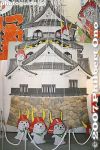
Hikone Castle kite, displayed in 2007, the 400th anniversary of the castle.Jun 12, 2013
|
|

Jun 12, 2013
|
|
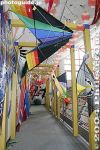
Kites from around the world.Jun 12, 2013
|
|

Kite from the USA, obviously.Jun 12, 2013
|
|

Jun 12, 2013
|
|
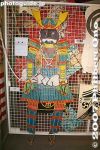
Samurai kiteJun 12, 2013
|
|
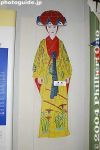
Okinawan dancer (yotsudake) kiteJun 12, 2013
|
|

Kite train, called rendako 連だこ, based on Awa Odori dancers in Tokushima Prefecture.Jun 12, 2013
|
|

Wind Goddess kite.Jun 12, 2013
|
|
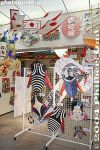
Jun 12, 2013
|
|
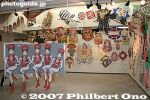
An incredible variety of kites are displayed. They come from all 47 prefectures of Japan and many foreign countries.Jun 12, 2013
|
|

Jun 12, 2013
|
|
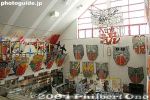
Hundreds of kites from all over Japan and the worldJun 12, 2013
|
|
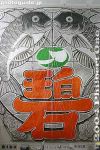
The design is also characterized by having a pair of creatures and a Japanese kanji character. Together, they indicate a clever meaning based on word play.Jun 12, 2013
|
|
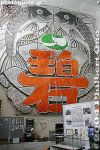
Giant kite displayed until 2004.Jun 12, 2013
|
|
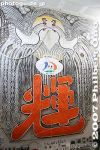
What makes the kite unique is that the kite paper is carved with numerous cutouts, based on the design. It is not a solid sheet of paper.Jun 12, 2013
|
|
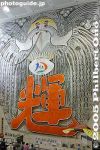
The giant kite measures about 13 high and 12 meters across, or the size of 100 tatami mats. This kite flew during 2002-2004. A new giant kite is made every three years.Jun 12, 2013
|
|

The Yokaichi Giant Kite Museum exhibits the city's giant kite used previously, as well as many different kites from all over Japan and the world. About 20-min. walk from Ohmi Railways Yokaichi Station. MapJun 12, 2013
|
|
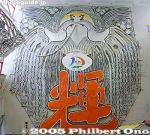
The giant kite is replaced every three years. The previous giant kite is displayed in the museum, while the current giant kite is flown on the last Sunday in May near Echigawa River.Jun 12, 2013
|
|
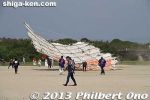
Jun 05, 2013
|
|
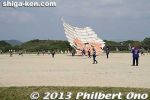
Jun 05, 2013
|
|
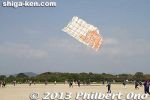
Jun 05, 2013
|
|
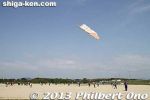
Although the kite left the ground each time, it didn't stay in the air for long.Jun 05, 2013
|
|
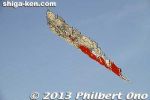
Jun 05, 2013
|
|
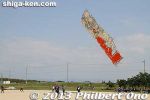
Jun 05, 2013
|
|
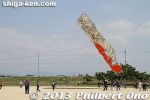
This is the last flight of several that day.Jun 05, 2013
|
|
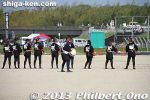
Jun 05, 2013
|
|

Around 100 people pull the giant kite. Junior high and older people can sign up to pull the kite.Jun 05, 2013
|
|
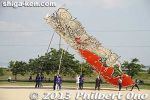
Jun 05, 2013
|
|
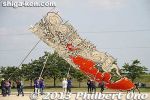
Jun 05, 2013
|
|

Jun 05, 2013
|
|
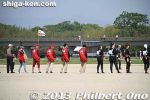
Members of the Giant Kite Preservation Society pull the front of the rope.Jun 05, 2013
|
|
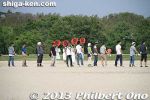
Jun 05, 2013
|
|
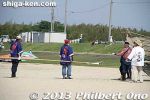
Jun 05, 2013
|
|
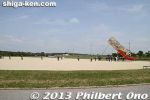
The kite pullers get ready to run. A small taiko drum beats, faster and faster.Jun 05, 2013
|
|

First they use long poles to prop up the giant kite.Jun 05, 2013
|
|
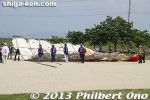
Afternoon flying session from 2:30 pm to 3 pm when the festival ended.Jun 05, 2013
|
|

Wind Goddesses fanning wind the traditional way.Jun 05, 2013
|
|

Giant kite pullers.Jun 05, 2013
|
|

Jun 05, 2013
|
|
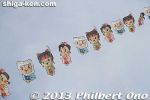
Behind Hikonyan were Nagahama's Azai sister trio (Chacha, Hatsu, and Go).Jun 05, 2013
|
|
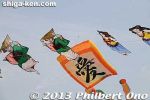
Jun 05, 2013
|
|
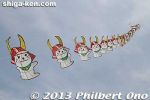
Hiko-nyan kite trainJun 05, 2013
|
|
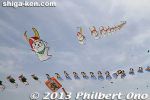
Hiko-nyan kite train and hula girl arch kiteJun 05, 2013
|
|
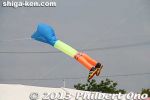
Flying trousersJun 05, 2013
|
|
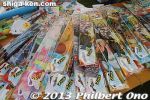
Kites for sale.Jun 05, 2013
|
|
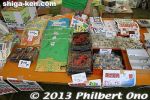
Stall selling kites. The long kite trains were sold out.Jun 05, 2013
|
|
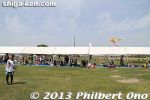
This is the first time they used this park for the festival. Closer to Lake Biwa so the wind should be stronger.Jun 05, 2013
|
|
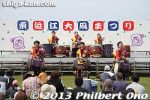
Taiko drummers.Jun 05, 2013
|
|
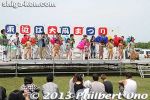
Higashi-Omi has a sizable Brazilian population.Jun 05, 2013
|
|
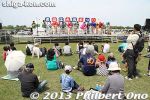
The entertainment stage provided entertainment like samba dancing and taiko drummers.Jun 05, 2013
|
|
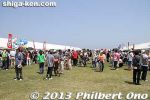
Lunch time! In the middle of the park are food booths and an entertainment stage.Jun 05, 2013
|
|
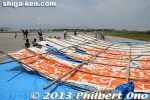
The villages then started competing in kite-making and the size grew larger and larger. The giant kite they fly today is the size of 100 tatami mats (13 m x 12 m). The Higashi-Omi Giant Kite Preservation Society (東近江大凧保存会) maintains the kiJun 05, 2013
|
|

Higashi-Omi's giant kite is a National Intangible Folk Cultural Property (選択無形民俗文化財) with a 300-year history. It started with villages flying kites for Boy's Day in May to celebrate the birth of a boy.Jun 05, 2013
|
|
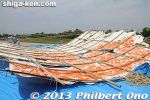
We visit the giant kite at rest. The back of the kite has many stickers written with kids' wishes.Jun 05, 2013
|
|
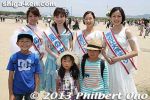
The four Wind Goddesses pose for us. The four Wind Goddesses (風の女神) are like festival princesses and they beckon the wind to blow during the kite festival.Jun 05, 2013
|
|

Jun 05, 2013
|
|

This kite's hanjimon has twin dragons that can be pronounced "shin-shin" (辰辰), a homonym for mind and body (心身). And the vermillion kanji reads "sukoyaka" (健やか), meaning good health. So the kite wishes for your "Jun 05, 2013
|
|
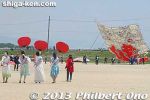
The hanjimon (判じもん) kite design always has a twin pair of creatures and a large kanji character. Together they form a thematic catch phrase.Jun 05, 2013
|
|

The kite is unique for its cutout and hanjimon (判じもん) design. Jun 05, 2013
|
|
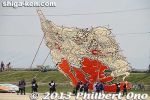
Made of washi paper (from Mino, Gifu) and a bamboo frame, the giant kite measures 13 meters high and 12 meters wide and weighs 700 kg.Jun 05, 2013
|
|

They were going to pull the kite across the width of the park since the way blew that way.Jun 05, 2013
|
|
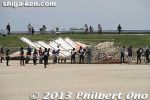
At sround 11:30 am, they cleared the area and brought out the giant kite (odako).Jun 05, 2013
|
|
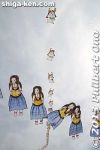
Hiko-nyan (Hikone Castle's official mascot) meets hula girls!Jun 05, 2013
|
|
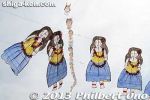
Jun 05, 2013
|
|
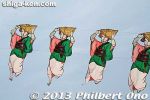
The Awa Odori dancers also danced great in the wind. (Watch my video.)Jun 05, 2013
|
|
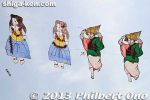
Jun 05, 2013
|
|
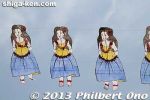
Their feet fluttered in the wind and their hips rocked left and right like real hula dancers.Jun 05, 2013
|
|
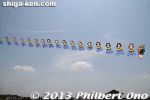
Jun 05, 2013
|
|

Needless to say, this was my favorite kite at the festival. How did they know someone from Hawaii was coming?Jun 05, 2013
|
|
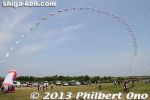
Huge arch kite of hula girls and Awa Odori dancers.Jun 05, 2013
|
|
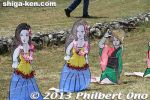
They're even wearing a lei and a flower in their hair!!Jun 05, 2013
|
|
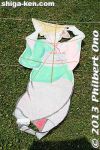
The hula girls were joined by Awa Odori girls from Tokushima.Jun 05, 2013
|
|
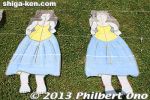
Back of the hula girls.Jun 05, 2013
|
|

To my delight, it was an arch kite of hula girls.Jun 05, 2013
|
|
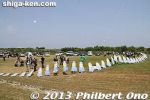
Then I stumbled across this arch kite.Jun 05, 2013
|
|
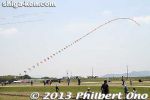
Jun 05, 2013
|
|
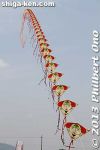
Jun 05, 2013
|
|
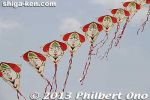
Jun 05, 2013
|
|
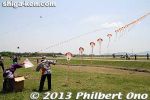
Kite trains (連凧) are the crowd favorite.Jun 05, 2013
|
|
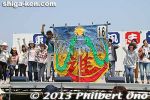
This team is from Higashi-Omi City Hall's young employees group.Jun 05, 2013
|
|
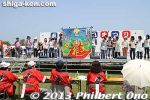
Thirty teams made "mini giant kites" and competed in kite design (図柄) and flying (飛揚). They went on the outdoor stage for kite design judging.Jun 05, 2013
|
|
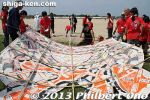
Jun 05, 2013
|
|
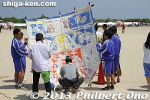
About 30 teams competed in kite-flying and design contests.Jun 05, 2013
|
|
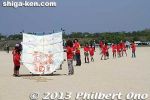
The kites are the size of two tatami mats.Jun 05, 2013
|
|

Kite-flying contest.Jun 05, 2013
|
|
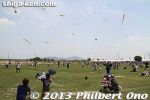
Jun 05, 2013
|
|

Free shuttle buses ran from JR Notogawa Station to the park which had no public parking. Jun 05, 2013
|
|
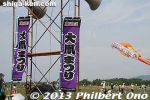
The festival name changed from Yokaichi Odako Matsuri to Higashiomi Odako Matsuri in May 2012 and the festival site changed in May 2013 to Fureai Undo Koen Park. MapJun 05, 2013
|
|

The Higashi-Omi Giant Kite Festival (Higashi-Omi Odako Matsuri) is held on the last Sunday of May at Fureai Undo Park (ふれあい運動公園) in Notogawa, HigashiOmi, Shiga. The main highlight is the giant kite, flying at 11:30 am and 2:30 pm.My video of the Higashi-Omi Giant Kite Festival on May 26, 2013. Due to a tragic kite crash in May 2015, this kite festival has been suspended since May 2016. It will not be held in May 2019 either.Jun 05, 2013
|
|
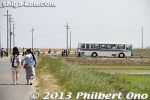
Also see kite-flying contests, exotic kites from around Japan, and stage entertainment. Anybody can fly a kite too. From 10 am to 3 pm. Jun 05, 2013
|
|

About the Iba Goten Palace. 伊庭御殿遺跡Jun 29, 2011
|
|

Jun 29, 2011
|
|
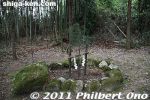
Jun 29, 2011
|
|

The palace seems to have had a large spread. The palace is known to have been designed by Kobori Enshu, a famous artist from Shiga. The place is now used as a park.Jun 29, 2011
|
|

Small monument at Iba Goten.Jun 29, 2011
|
|

Near the Sanposan Shrine is the site of the Iba Goten Palace.Jun 29, 2011
|
|

The Iba Goten Palace was a rest house for shoguns traveling between Tokyo and Kyoto during the early Tokugawa Period. 伊庭御殿遺跡Jun 29, 2011
|
|

Jun 29, 2011
|
|

Jun 29, 2011
|
|
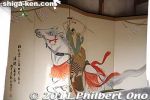
Jun 29, 2011
|
|

Looks like the mikoshi storehouse.Jun 29, 2011
|
|
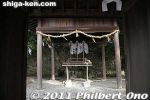
Jun 29, 2011
|
|
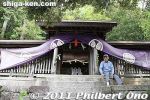
Sanposan Shrine near the bottom torii.Jun 29, 2011
|
|
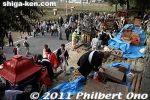
Jun 29, 2011
|
|

The three mikoshi are being readied for their next destination at another shrine nearby.Jun 29, 2011
|
|
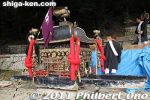
Jun 29, 2011
|
|

Jun 29, 2011
|
|

They put the ornaments back on.Jun 29, 2011
|
|

Jun 29, 2011
|
|
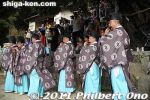
Shrine musicians play as the mikoshi arrive.Jun 29, 2011
|
|
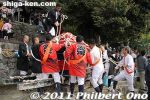
They undo the ropes covering the mikoshi.Jun 29, 2011
|
|

Jun 29, 2011
|
|

All three mikoshi are placed near the torii,Jun 29, 2011
|
|
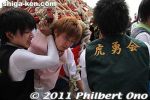
Jun 29, 2011
|
|
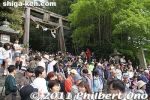
Jun 29, 2011
|
|
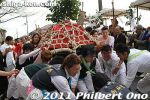
Jun 29, 2011
|
|
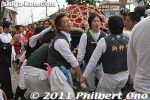
After hitting the paved road, they carry the mikoshi to a place nearby.Jun 29, 2011
|
|
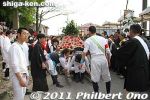
Jun 29, 2011
|
|
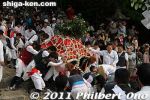
Jun 29, 2011
|
|
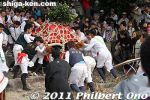
Jun 29, 2011
|
|
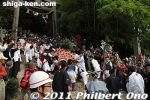
Jun 29, 2011
|
|
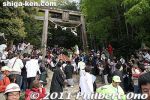
Jun 29, 2011
|
|

The third and red mikoshi Ninomiya passes through the torii. 二の宮Jun 29, 2011
|
|
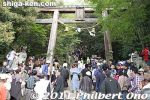
Jun 29, 2011
|
|
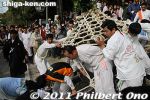
The second mikoshi Hachioji hits the pavement.Jun 29, 2011
|
|
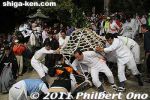
Jun 29, 2011
|
|
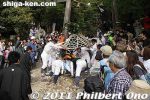
The third mikoshi, called Ninomiya, passes through the torii. 二の宮 Jun 29, 2011
|
|
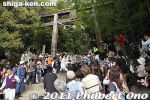
Jun 29, 2011
|
|

The second mikoshi, called Hachioji, passes through. 八王子Jun 29, 2011
|
|
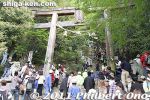
Jun 29, 2011
|
|
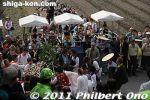
Jun 29, 2011
|
|

Jun 29, 2011
|
|
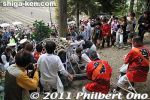
Two people behind the mikoshi hold ropes attached to the mikoshi.Jun 29, 2011
|
|
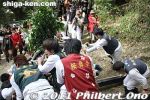
Jun 29, 2011
|
|
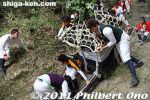
Jun 29, 2011
|
|

Jun 29, 2011
|
|
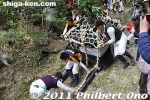
The second mikoshi, called Hachioji, passes through. 八王子Jun 29, 2011
|
|
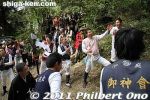
They sing a song as they drag the mikoshi. It's a contsant stop-and-go process.Jun 29, 2011
|
|
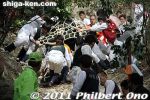
The Sannomiya mikoshi passes in front of us as they dragged it down the rocky slope. People do get hurt. I saw one guy who had hurt his foot, but was able to walk back down the mountain while accompanied by a fireman.Jun 29, 2011
|
|
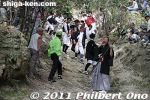
Jun 29, 2011
|
|
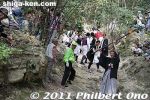
The first mikoshi called Sannomiya finally arrives near the bottom.Jun 29, 2011
|
|

My YouTube video of the Iba-no-saka-kudashi Matsuri.Jun 29, 2011
|
|
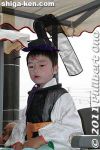
Jun 29, 2011
|
|

Jun 29, 2011
|
|
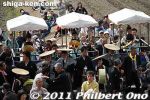
Three costumed boys wait right beyond the torii.Jun 29, 2011
|
|
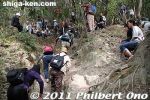
As the first mikoshi's scheduled arrival time nears, more people gather and climb the slope.Jun 29, 2011
|
|
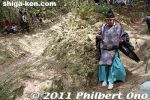
A shrine priest in full dress climbs down to my amazement.Jun 29, 2011
|
|

The kids are not afraid at all of the steep slope. The secret is to travel light. I was too bogged down with camera equipment and decided to stay near the bottom torii which tends to get most crowded.Jun 29, 2011
|
|

Quite a few people climbed up, and they seemed to be locals who have been climbing up the mountain a number of times even with young kids in hand.Jun 29, 2011
|
|
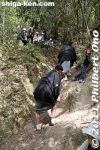
If you want to climb up the slope to see the mikoshi at higher-up rough spots, you have to climb up. Jun 29, 2011
|
|
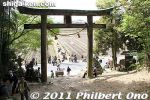
Jun 29, 2011
|
|

It makes you wonder how they can carry a heavy mikoshi down such a steep and rough slope. Jun 29, 2011
|
|
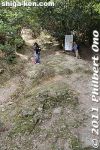
Jun 29, 2011
|
|

About the Ibanosaka-kudashi Matsuri.Jun 29, 2011
|
|
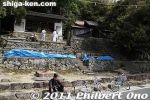
A few shrine buildings near the bottom torii.Jun 29, 2011
|
|

The torii is right on the bottom of the steep and rocky mountain slope.Jun 29, 2011
|
|
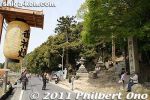
People start to gather near the bottom torii, a point called Sakashita (Slope Bottom). 坂下Jun 29, 2011
|
|

Those rough spots can be exceptionally steep or difficult to pass for the men carrying the mikoshi portable shrine down the mountain. It's only 500 meters, but very steep and rocky.Jun 29, 2011
|
|
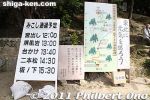
Rough timetable of the three portable shrines being hauled down the steep mountain. There are several points of interest (rough spots which are all named) and the approximate times when they will pass by.Jun 29, 2011
|
|
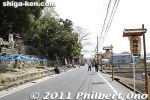
Area around the bottom torii of Sanposan Shrine. MapJun 29, 2011
|
|
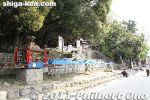
They carry the three mikoshi portable shrines up to Sanposan Shrine atop the mountain on May 3, the day before the festival on May 4. The god's spirit is then transferred to the mikoshi. One mikoshi is already on the ground.Jun 29, 2011
|
|

Some Jizo statues along the way to Sanposan Shrine from Notogawa Station.Jun 29, 2011
|
|

Part of Sanposan Shrine can be seen atop on Kinugasa-yama. The festival is related to the Junishi Chinese zodiac. They sing about the dragon going up the mountain and slithering down as a snake.Jun 29, 2011
|
|

Held on May 4 by Sanposan Shrine in Higashi-Omi, Shiga Prefecture, Iba-no-saka-kudashi Matsuri has three portable shrines hauled down a steep mountain (Kinugasa-yama) for about 500 meters. Jun 29, 2011
|
|

View of the bottom torii of Sanposan Shrine (繖峰三神社) on Kinugasa-yama (繖山) 432 meters high. (As seen from the train on the JR Tokaido Line. This torii is 15-min. walk from JR Notogawa Station. 繖峰三神社)Jun 29, 2011
|
|

Sister city monument at Higashi-Omi City Hall.Sep 04, 2009
|
|

Higashi-Omi City Hall Sep 04, 2009
|
|

Chokotto bus ちょこっとバスSep 04, 2009
|
|

Ohmi Railways Yokaichi Station 近江鉄道八日市駅Sep 04, 2009
|
|

Higashi-Omi City Hall Sep 04, 2009
|
|

Mural at Ohmi Railways Yokaichi StationSep 04, 2009
|
|

On May 25, 2008 at the Yokaichi Giant Kite Festival, the new giant kite was flown for the first time. The wind conditions was good.May 31, 2008
|
|
|

It had rained the night before and in the morning. The ground would've been muddy, but they spread a layer of rocks to make the ground dry. It must have been hard to pull the kite and run on these rocks.May 31, 2008
|
|

After the flight, we could see the kite up close. A sacred sakaki tree branch adorned the back of the kite. Also many paper stickers with people's wishes were pasted on the back.May 31, 2008
|
|

The paper flaps are applied with paste and then folded over the bamboo rod.Sep 14, 2007
|
|

See the paper flaps pasted over the edge.Sep 14, 2007
|
|

Sep 14, 2007
|
|

Almost finished. This paper cutting step took 3 days to complete.Sep 14, 2007
|
|

Wing portion after paper cutting.Sep 14, 2007
|
|

Sep 14, 2007
|
|

Wing portion before paper cutting.Sep 14, 2007
|
|

How they do it: First they cut along the outline of the picture leaving ample space. Then they cut it perpendicular to the edge to make paper flaps.Sep 14, 2007
|
|

The bamboo grid was temporarily fixed with weights and some tape.Sep 14, 2007
|
|

Intricate bamboo grid/frame fitting all shapes along the edges.Sep 14, 2007
|
|

The bamboo grid is carefully aligned with the kite design.Sep 14, 2007
|
|

Aug. 5, 2007: Paper cutting 切り抜き Kiri-nuki. First they reversed the kite paper so the bottom side was up. Then they re-installed the bamboo grid as shown here.Sep 14, 2007
|
|

Group photo. Quite a few people worked during this 3-hour afternoon session.Aug 02, 2007
|
|

Still more tying to do.Aug 02, 2007
|
|

Besides the diagonal grid of bamboo rods, a bamboo rod is also fastened along the edges of the design where the paper will be cut out (or carved out). These bamboo rods keep the edges of the cut-out paper taut. Otherwise it would flap around in the wind.Aug 02, 2007
|
|

Tying the bamboo frame is considered to be one of the more tedious tasks, so we were rewarded with a pair of gloves with the kite design. These gloves will also give us higher priority to pull the kite during the kite festival.Aug 02, 2007
|
|

Aug 02, 2007
|
|

WingAug 02, 2007
|
|

Hawk eye painted.Aug 02, 2007
|
|

Aug 02, 2007
|
|

Bamboo rods and sticks.Aug 02, 2007
|
|

The bamboo frame work is done after the kite design is painted.Aug 02, 2007
|
|

This intricate bamboo frame supports the kite paper so it does not flap around like normal paper.Aug 02, 2007
|
|

Aug 02, 2007
|
|

Kite edges are lined with a thicker bamboo to which the rod-like bamboo are tied.Aug 02, 2007
|
|

July 31, 2007: Bamboo frame work and picture-edge frame work. 骨組(絵骨)Hone-gumi (Ebone)Aug 02, 2007
|
|

Tied bamboo intersections. The rod-like bamboo are supported by larger pieces of bamboo.Aug 02, 2007
|
|

A diagonal grid of thin, rod-like bamboo criss-crossed the entire kite. They are now using string to tie the bamboo intersections.Aug 02, 2007
|
|

Aug 02, 2007
|
|

Aug 02, 2007
|
|

Vermilion painting of "sei" is complete.Aug 02, 2007
|
|

Group photo of those who worked on the kite this time. This session was 9:30 am to noon.Aug 02, 2007
|
|

A brush stroke effectAug 02, 2007
|
|

Aug 02, 2007
|
|

Aug 02, 2007
|
|

Hawk eyeAug 02, 2007
|
|

The sketch of the hawk is completed.Aug 02, 2007
|
|

"Yorokobu" or "ki"Aug 02, 2007
|
|

Wing cornerAug 02, 2007
|
|

The "yorokobu" or "ki" kanji is also painted on the same day.Aug 02, 2007
|
|

The design sketch is being completed.Aug 02, 2007
|
|

Local cable TV station also came to cover the kite-making progress.Aug 02, 2007
|
|

Vermilion paintAug 02, 2007
|
|

Plastic pails and brushesAug 02, 2007
|
|

The red and ornage colors are painted first on the kite, while the black and gray colors are painted later.Aug 02, 2007
|
|

Aug 02, 2007
|
|

Spots of white are made on purpose to give a brush stroke effect.Aug 02, 2007
|
|

Aug 02, 2007
|
|

July 16, 2007: Initial sketching and vermilion painting. A sketch of the design was made with a charcoal pencil. 下絵・墨Aug 02, 2007
|
|

The giant kite's main and largest kanji character "sei" is painted in vermilion.Aug 02, 2007
|
|

Aug 02, 2007
|
|

A plastic bucket (the same kind used when you take a bath) with paint and a brush is used.Aug 02, 2007
|
|

The work proceeds.Jul 09, 2007
|
|
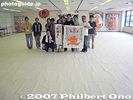
After every kite-making session, they take a picture of all the volunteer participants. It was very interesting. Anybody can participate on any day. Call the kite museum for schedule details: 0748-23-0081.Jul 09, 2007
|
|

The sheets are joined in the same pattern as a brick wall. Every other row of sheets has a half sheet along the edge. Notice the autographs of people on the paper.Jul 09, 2007
|
|
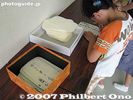
There are also smaller sheets of paper where you can write a wish and sign your name. Paste will be applied to these sheets which will be used to fasten the bamboo frame to the giant paper.Jul 09, 2007
|
|

The giant kite paper is finished, taking up the floor space of the entire room.Jul 09, 2007
|
|

The last sheet is pasted and joined. The job was finished in 3 hours.Jul 09, 2007
|
|

So the giant kite is actually made of many smaller sheets of paper joined together. Notice my "philbert" autograph on the bottom.Jul 09, 2007
|
|

People sign their names on a washi sheet.Jul 09, 2007
|
|

Anybody can help do this. The public is invited to sign their names on a sheet and paste it to the big kite paper.Jul 09, 2007
|
|

The paper is Mino Washi, from Gifu Prefecture. It is white, and surprisingly thin. I thought it would be thicker. Six or so sheets are stacked while slightly spread apart.Jul 09, 2007
|
|

The stacked paper is put on a table where water-based paste is applied to one horizontal and one vertical paper edge.Jul 09, 2007
|
|

Each person holds one edge-pasted sheet and line up to align and join the sheet. Each sheet measures about 90 cm by 60 cm. There are also half-size sheets.Jul 09, 2007
|
|

The top two rows of washi sheets already pasted together.Jul 09, 2007
|
|

The size of the room almost exactly matches the size of the giant kite which is 12 meters by 13 meters or 100 tatami mats.Jul 09, 2007
|
|

July 8, 2007: On the day after the pasting ceremony, the Kamitsugi or paper joining was next. 紙継ぎJul 09, 2007
|
|
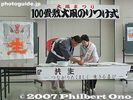
More dignitaries paste the sheets of kite paper together.Jul 09, 2007
|
|

The kite design announcement and pasting ceremony lasted an hour, after which a group photo was taken.Jul 09, 2007
|
|

Starting at 9:30 am, members of the giant kite preservation society began pasting and joining about 400 sheets of washi paper to make the giant kite paper.Jul 09, 2007
|
|
| 1122 files on 5 page(s) |
 |
3 |  |
|